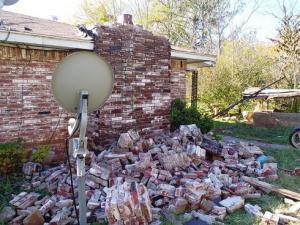EarthquakesFracking-related quakes make central U.S. as vulnerable as California to tremor damage
For the first time, new USGS maps identify potential ground-shaking hazards from both human-induced and natural earthquakes. The new report shows that approximately seven million people live and work in areas of the central and eastern United States (CEUS) with potential for damaging shaking from induced seismicity. Within a few portions of the CEUS, the chance of damage from all types of earthquakes is similar to that of natural earthquakes in high-hazard areas of California.

Earthquake damage in Oklahoma // Source: commons.wikimedia.org
For the first time, new USGS maps identify potential ground-shaking hazards from both human-induced and natural earthquakes. In the past, USGS maps only identified natural earthquake hazards. This is also the first one-year outlook for the nation’s earthquake hazards, and is a supplement to existing USGS assessments that provide a 50-year forecast.
The report shows that approximately seven million people live and work in areas of the central and eastern United States (CEUS) with potential for damaging shaking from induced seismicity. Within a few portions of the CEUS, the chance of damage from all types of earthquakes is similar to that of natural earthquakes in high-hazard areas of California.
“By including human-induced events, our assessment of earthquake hazards has significantly increased in parts of the U.S.,” said Mark Petersen, chief of the USGS National Seismic Hazard Mapping Project. “This research also shows that much more of the nation faces a significant chance of having damaging earthquakes over the next year, whether natural or human-induced.”
Induced earthquakes are triggered by human activities, with wastewater disposal being the primary cause for recent events in many areas of the CEUS. Wastewater from oil and gas production operations can be disposed of by injecting it into deep underground wells, below aquifers that provide drinking water.
USGS notes that USGS scientists only distinguished between human-induced and natural seismicity in the CEUS. In the west, scientists categorized all earthquakes as natural. Scientists also used a different methodology in looking at the CEUS compared to the west.
Six states face the highest hazards
The most significant hazards from induced seismicity are in six states, listed in order from highest to lowest potential hazard: Oklahoma, Kansas, Texas, Colorado, New Mexico, and Arkansas. Oklahoma and Texas have the largest populations exposed to induced earthquakes.
“In the past five years, the USGS has documented high shaking and damage in areas of these six states, mostly from induced earthquakes,” said Petersen. “Furthermore, the USGS Did You Feel It? Web site has archived tens of thousands of reports from the public who experienced shaking in those states, including about 1,500 reports of strong shaking or damage.”
